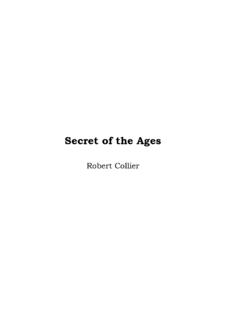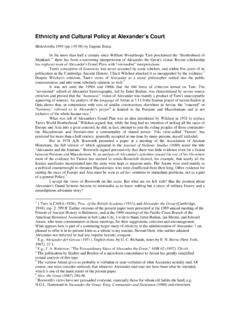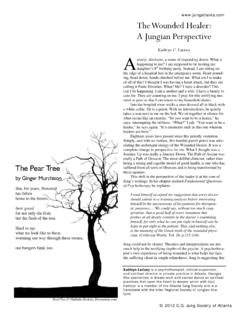Transcription of Metallurgy for the Non Metallurgist - HABA …
1 1 Metallurgy for the Non MetallurgistLesson 1A History of MetalsOctober 02, 2008 Richard Boswell, EngineerBlacksmith2A History of Metals Upon completion of the lesson, we will be able to: Summarize the history of Metallurgy from ancient to modern times. Define metal, ore, alloy, refining and smelting. Outline the relative availability of specific Reference Document for this classASM Course 0135 Lesson 14 Terminology Metal a mineral or compound naturally occurring near the Earth surface and is sometimes described as a lattice of positive ionssurrounded by a cloud of delocalized electrons. An element that readily loses electrons to form positive ions (cations) and forms metallic bonds between other metal atoms Ore a volume of rock containing components or minerals that have economic value Alloy combination of metals by melting (naturally or intended) Refining selective removal of metal from ore Smelting extracting metal from ore by heating 5 History of Metals What is a metal?
2 Opaque, lustrous element that is a good conductor of electricity and heat and a good reflector of light when polished. Crystalline in the solid state Solid at ambient temperaturesoExcept for MercuryPolished low alloy steel showing light reflection7 History of Metals Ancient Metals Most metals naturally occur as minerals or compounds Ancient man used Gold, Silver or Copper because they naturally existed in the form of metals Copper ore reduction from copper sulfides (covellite and malachite) began between 4000 and 3000 Two important ancient could be obtained from ores by heatingoStrength could be increased by hammering8 History of Metals Bronze Age Addition of tin to copper to form bronzeo~ 88% Cu -12% Sn By 3000 B. C. ancient metallurgists had learned to intentionally mix ores of copper and tin to produce bronze, similar to today s of AntiquityThe metals upon which civilization was based. These seven metalswere: (1) Gold 6000 BC (2) Copper 4200 BC (3) Silver 4000 BC (4) Lead 3500 BC (5) Tin -1750 BC (6) Iron, smelted -1500 BC (7) Mercury 750 BC These metals were known to the Mesopotamians, Egyptians, Greeks and the Romans.
3 Of the seven metals, five can be found in their native states, , gold, silver, copper, iron (from meteors) and mercury. 10 TIMELINE11 Time-Life Books Emergence of ManThe Metalsmiths1974 Fifth Century Smiths forging sickle at La Tenein Lower Austria12 Smiths forge at La Tene in Lower Austriawas used 2500 years ago13 Celtic tools fromLa Tene were used 2500 years ago14 Technology Distribution Part 1 Celtic Iron Age technology is commonly considered to begin around 1000 and lasting through 100 in Celtic Britain and ended with the arrival of Roman Advent of Iron in Celtic Briton The use of iron had amazing repercussions. First, it changed trade and fostered local independence. Trade was essential during the Bronze Age, for not every area was naturally endowed with the necessary ores to make bronze. Iron, on the other hand, was relatively cheap and available almost technology distribution ..and removal Roman influence shaped the world until the Barbarian invasions changed it again, and Goths Huns Vandals Viking (Crusades) Mongols In England the Viking Age began dramatically on January 6, 793 when Norsemen destroyed the abbey on Lindisfarne, a center of learning famous across the continent.
4 The Vikings who invaded western and eastern Europe were chiefly from Denmark, Norway and Sweden. They also settled the Faroe Islands, Iceland, Greenland and (briefly) North World Metal Centers date to 9500 and were either sources or manufacturing Tut funeral mask of beaten ,Silver, and Electrum (natural alloy of gold and silver)20 Multicolored CopperComponents of Bronze (Copper and Tin)21 Iron,a metal for the Masses is second most common sources were meteoric forms before smelting mastered in 1200 is Extraction of Metal from Ore Smelting is Extraction of Metal from Ore Gold already pure in nature and not extracted Silver and Lead 4000 Tin 3000 Iron 2700 Requires a very hot fire Technology borrowed from Ceramic/Pottery Crafts? Charcoal for fuel Air is blown into the fire23 Common IssuesThese seven metals: gold, silver, copper, lead, tin, mercury and iron, and the alloys bronze and electrum were the starting point of Metallurgy and even in this simple, historic account we find some of the basic problems of process Metallurgy .
5 The problems are: The ores must be found, separated and sized before use. The ores must be reacted under a controlled temperature and gas atmosphere. The liquid metal must be collected and cast into a desired shape. The metal must be worked to achieve desired final properties and shape. 24 History of DiscoveryBefore 1700 there were 12 metals in common use: Gold Silver Copper Lead Mercury Iron Tin Platinum Antimony Bismuth Zinc Arsenic 12 Metals Discovered in 18th Century: 1735 Cobalt 1751 Nickel 1774 Manganese 1781 Molybdenum 1782 Tellurium 1783 Tungsten 1789 Uranium 1789 Zirconium 1791 Titanium 1794 Yttrium 1797 Berylium 1797 ChromiumBefore 1805 all metals were reduced by either carbon or hydrogen2542 METALS DISCOVERED IN 19thCENTURY 1801 Niobium 1802 Tantalum 1803 Iridium, Palladium, Rhodium 1807 Potassium, Sodium 1808 Boron, Barium, Calcium, Magnesium, Strontium 1814 Cerium 1817 Lithium, Cadmium, Selenium 1823 Silicon 1827 Aluminum 1828 Thorium 1830 Vanadium 1839 Lanthanum 1843 Erbium, Terbium 1844 Ruthenium 1860 Cesium, Rubidium 1861 Thallium 1863 Indium 1875 Gallium 1878-1885 Holmium, Thulium, Scandium, Samarium, Gadalinium,Praseodynium, Neodynium, Dysprosium 1886 Germanium 1898 Polonium.
6 Radium 1899 Actinium 2620 METALS DISCOVERED IN 20thCENTURY 1901 Europium 1907 Lutetium 1917 Protactinium 1923 Hafnium 1924 Rhenium 1937 Technetium 1939 Francium 1945 Promethium 1940-61 Transuranium elements Neptunium Plutonium Curium Americum Berkelium Californium Einsteinium Fermium Mendelevium Nobelium Lawrencium 27 Civilizations and Eras defined by their Material Technology Stone Age Copper Age Bronze Age Iron Age Dark Ages Medieval Ages Modern Metal Age consists of many over-lapping Technical Ages after 1300 Age of Steel Petroleum Age Industrial Age Age of Flight Space Age -Sputnik Nuclear Age Computer Age Composite Material Age Nano Tech Age Green Age ?28 Design Technology Change form Compression to Tension With the Industrial Revolution in the 19th century, truss systems of wrought iron were developed for larger bridges, but iron did not have the tensile strength to support large loads. With the advent of steel, which has a high tensile strength, much larger bridges were built, many using the ideas of GustaveEiffel.
7 The Eiffel Tower was built for the International Exhibition of Paris of 1889 Riveted lattice wind resistant design The Forth Bridge is a cantilever railway bridge over the Firth of Forth in the east of Scotland opened in 189029 Technologies Fade Away Blacksmith Essential skills for 12,000 years Industrial Age made the skill obsolete around 1930 Smiths migrated into towns and were absorbed by other industries such as large industrial forge shops and auto repair garages Metallurgy and Materials Essential skills for 500 years Tomorrow? Will Green Age and composite materials render Metallurgy obsolete? Will natural and/or man-made disaster erase today s centers of learning and manufacture?30 Georgius Agricola (1494-1555) Georg Bauer, better known by the Latin version of his name Georgius Agricola, is considered the founder of geology as a discipline. He died in 1555, one year before the posthumous publication of De Re Metallica, his greatest work.
8 De Re Metallica(Latin for On the Nature of Metals (Minerals)) is a book cataloging the state of the art of mining, refining, and smelting metals, published in 1556. The publication was delayed until the completion of the extensive and detailed woodcuts. He describes the method of breaking hard rocks using fire-setting, which involved making a fire against a rock-face, and then quenching the rock with water to induce cracking by thermal shock. In 1912, the first English translation of De Re Metallica was privately published in London by subscription. The translators were Herbert Hoover, a mining engineer (and later President of the United States), and his wife, Lou Henry Hoover, a geologist and Age Weapons32 Coins Romans exported coin technology to Celtic Britton. Currency evolved from two basic innovations: the use of counters to assure that shipments arrived with the same goods that were shipped, and later with the use of silver ingots to represent stored value in the form of grain.
9 Both of these developments had occurred by 2000 BC. Originally money was a form of receipting grain stored in temple granaries in ancient Egypt and Roman denarius, a standardized silver of Lydia Electrum coin. Early 6th century 20-stater of Eucratides I ( reigned 171 145 BC),the largest gold coin ever minted in Antiquity33 Celtic Metal Art La T ne culture developed and flourished during the late Iron Age (from 450 BCE to the Roman conquest in the 1st century BCE) in eastern France, Switzerland, Austria, southwest Germany, the Czech Republic, Slovakia and Hungary. Celtic art in the Middle Ages was practiced by the Celtic speaking people of Ireland and Britain in the 800 year period from the Roman withdrawal from Britain in the 5th century, to the establishment of Romanesque art in the 12th century34 Nails Bronze nails, found in Egypt, have been dated 3400 BC. In 1959 during excavation of the legionary fortress at Inchtuthil near Dunkeld, archaeologists uncovered a singularly remarkable haul of a single kind of Roman artifact from around 83 - 87 AD.
10 Located in a twelve foot deep pit below the beaten earth floor of the workshop - the Fabrica- was a remarkable hoard of nails, over eight hundred thousandin number, many in a remarkable state of preservation. Pig iron was commonly imported into Roman Britain from iron producing areas of the empire- notably lower Germany- in small man hand-able billets. An original 7" (180mm) long Roman nail found in Scotland19thCentury "Square" NailsReplica of the hand made nails found on board the 'Mary Rose -Tudor flag ship of Henry VIII built in 1509 Roman nail found in Wales35 Viking Swords and Utensils Viking Age is the term denoting the years from about 700 to 1066 in European history. Viking society was based on agriculture and trade with other peoples. They acquired technology from around the world. Metal crafts in Scandinavia were of a very high standard as regards the execution and craft skills. 36 History of Metals Iron Smelting Iron production began in Anatolia in 2000 Iron production well established by 1000 Widely available sources of charcoal (from wood) and iron ore caused iron production to spread widely (in China) by 500 Intentional reduction of iron oxide ore using charcoal (from wood) was widespread in Egypt by 1500 B.







